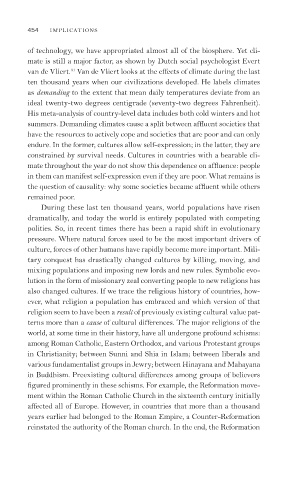Page 489 - Cultures and Organizations
P. 489
454 IMPLICATIONS
of technology, we have appropriated almost all of the biosphere. Yet cli-
mate is still a major factor, as shown by Dutch social psychologist Evert
31
van de Vliert. Van de Vliert looks at the effects of climate during the last
ten thousand years when our civilizations developed. He labels climates
as demanding to the extent that mean daily temperatures deviate from an
ideal twenty-two degrees centigrade (seventy-two degrees Fahrenheit).
His meta-analysis of country-level data includes both cold winters and hot
summers. Demanding climates cause a split between affluent societies that
have the resources to actively cope and societies that are poor and can only
endure. In the former, cultures allow self-expression; in the latter, they are
constrained by survival needs. Cultures in countries with a bearable cli-
mate throughout the year do not show this dependence on affl uence: people
in them can manifest self-expression even if they are poor. What remains is
the question of causality: why some societies became affluent while others
remained poor.
During these last ten thousand years, world populations have risen
dramatically, and today the world is entirely populated with competing
polities. So, in recent times there has been a rapid shift in evolutionary
pressure. Where natural forces used to be the most important drivers of
culture, forces of other humans have rapidly become more important. Mili-
tary conquest has drastically changed cultures by killing, moving, and
mixing populations and imposing new lords and new rules. Symbolic evo-
lution in the form of missionary zeal converting people to new religions has
also changed cultures. If we trace the religious history of countries, how-
ever, what religion a population has embraced and which version of that
religion seem to have been a result of previously existing cultural value pat-
terns more than a cause of cultural differences. The major religions of the
world, at some time in their history, have all undergone profound schisms:
among Roman Catholic, Eastern Orthodox, and various Protestant groups
in Christianity; between Sunni and Shia in Islam; between liberals and
various fundamentalist groups in Jewry; between Hinayana and Mahayana
in Buddhism. Preexisting cultural differences among groups of believers
figured prominently in these schisms. For example, the Reformation move-
ment within the Roman Catholic Church in the sixteenth century initially
affected all of Europe. However, in countries that more than a thousand
years earlier had belonged to the Roman Empire, a Counter-Reformation
reinstated the authority of the Roman church. In the end, the Reformation

